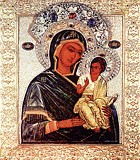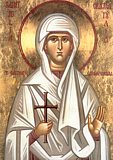

| Previous day | Next day |
| Old Style
July 16
|
Saturday |
New Style
July 29
|
| 8th Week after Pentecost. Tone 6. | No fast.
|
![]() Hieromartyr Athenogenes, bishop of Heracleopolis, and his ten disciples (ca. 311).
Hieromartyr Athenogenes, bishop of Heracleopolis, and his ten disciples (ca. 311).
Martyrs Paul and two sisters, Chionia (Thea) and Alevtina (Valentina), at Caesarea in Palestine (308). Martyr Antiochus, physician, of Sebaste (4th c.). Virgin-martyr Julia of Carthage, at Corsica (ca. 440 или 613). St. Theodotus, monk of Glinsk Hermitage (1859). St. Magdalena, schema-abbess of New Tikhvin Convent in Siberia (1934).
New Confessor Matrona Belyakova, fool-for-Christ, of Anemnyasevo (1936). New Hieromartyrs James (Maskaev), archbishop of Barnaul, and priests Peter and John, and with them Monk-martyr Theodore (Nikitin) and Martyr John (1937). New Hieromartyr Ardalion (Ponamarev), archimandrite, of Kasli (Chelyabinsk) (1938).
Icon of the Mother of God of Chirsk-Pskov (1420).
Martyr Helier of Jersey (6th c.). St. John of Vishnya and Mt. Athos, activist against Uniatism (c. 1630). New Martyr John of Turnovo (1822). 15,000 Martyrs of Pisidia.
Thoughts for Each Day of the Year
According to the Daily Church Readings from the Word of God
By St. Theophan the Recluse

Saturday. [Rom. 13:1-10; Matt. 12:30-37]
A good man out of the good treasure of the heart bringeth forth good things: and an evil man out of the evil treasure bringeth forth evil things. What you put in the treasury is what you receive: if you put in gold—you will take away gold; if you put in copper—you will take away copper. Of course, copper can be passed off as gold; but an expert will immediately recognize the forgery. How can we make it so that in our treasury there is only gold; that is, so that in the heart there is only good? The heart by its nature is a treasury of good things; evil came later. Take an anatomical knife of attentiveness and lack of self pity, separate what is unnatural and cut it out. One after the other the evil will leave, while the good will become strengthened and spread; what will remain, at last, will be only good. The question is how to determine what is natural and unnatural. Do not listen to today’s naturalists;[1] they explain everything inside out: what is natural, for them is unnatural; while what is unnatural, for them is natural—they call evil good, and good evil. Look at what the Lord says in the Gospels and the holy apostles in their writings, and according to their instructions determine what is natural. In such a manner, at last, you will gather much good and will bring it forth out of your heart. Pray to the Holy Spirit: “O treasury of good things, entreasure good in my heart!”
[1]By “naturalists” is meant those people who rely on natural science for answers, and deny religion.
Articles
 Martyr Antiochus the Physician of SebasteThe Holy Martyr Antiochus, a native of Cappadocian Sebastea, was the brother of the holy Martyr Platon (November 18), and he was a physician. |







